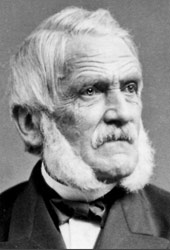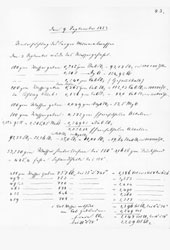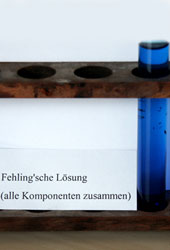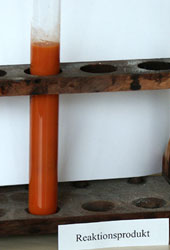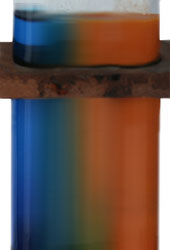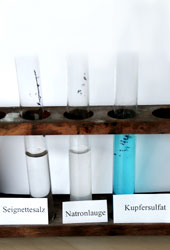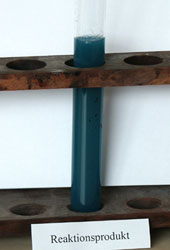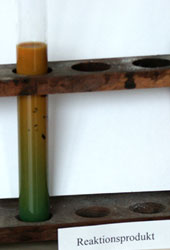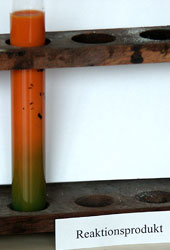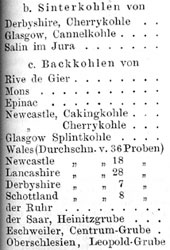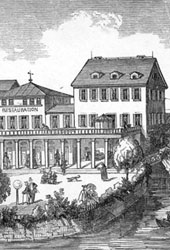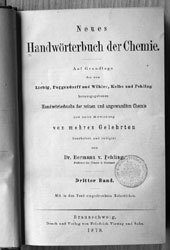 |
|
||||||||||||||||||||||||||||||||
|
|||||||||||||||||||||||||||||||||
|
Hermann Fehling and Chemistry at the Polytechnic By Beate Ceranski and Volker Ziegler While his nephew Ferdinand Fehling was studying in Göttingen, his nickname was "Lösung" ("solution"): so close was (and is) the connection between the name of Hermann Fehling and the copper (II) sulphate solution used as a test for sugar. To this day Fehling's solution is part of the repertoire of medicine, pharmacy and chemistry. But there is much more to the figure of Fehling, a Chemistry teacher at Stuttgart Polytechnical School from 1839 to 1883, than just a solution. He made Chemistry at Stuttgart into a show-piece and crowd-puller. He inspired and supported the industrialisation of Württemberg through his reports and research work. He battled with health problems, but built new institutes nevertheless. He travelled and wrote, and investigated medicines, blast furnace clinker, water and bread.
From Paris to the Swabian capitalOn 11 June 1839 the job of senior teacher of Chemistry and Technology was advertised in the Kingdom of Württemberg's official newspaper. Among the thirteen applicants was Hermann Fehling from Lübeck, who had just turned 28 years old. He started work in September 1839.
A Northerner in SwabiaAlthough Fehling was born in Lübeck, he had just returned from Paris at the time he applied for the post. He had crowned his training with a stay of several months in the French capital, then the world centre for the natural sciences. Fehling had first undergone an apprenticeship as a chemist, had then studied Chemistry in Heidelberg and subsequently spent two semesters working with Liebig in his laboratory in Gießen. After that, the 28-year-old had first-class training under his belt and equally impressive references to boot. So it came as no surprise that he was selected for the post. Yet initially he was only appointed on a temporary basis, as he had not yet proven his talents as a teacher. Thus to begin with Fehling kept his Lübeckian citizenship and lived in Swabia as a foreigner. It was only when he was given the position permanently in spring 1841 and married the daughter of a Stuttgart professor that Fehling became a citizen of Württemberg. The fact that the German-speaking world was divided into numerous single states didn't just make Fehling a foreigner in Württemberg, it also influenced his work. The government wanted him to only employ Württembergians as assistants. Yet this requirement couldn't always be fulfilled as there simply weren't yet enough young scientists in Württemberg. Yet when Fehling gave up his post at the Polytechnic in 1883, up-and-coming scientists from Württemberg were ready to follow in his footsteps. Fehling's more than forty years of teaching had borne the fruits of his endeavours. Background information: Lübeckian citizenship The new political order after the Napoleonic Wars of 1806 meant that almost all free cities of the German Empire had lost their independence to the larger German states such as Prussia. The Hanseatic city of Lübeck was one of the six remaining free cities. Background information: citizen of Württemberg The permanent post as senior teacher did give Fehling Württemberg citizenship, but it was linked to the post. Thus if Fehling had given up his post at Stuttgart Polytechnic, he would no longer have been a Württembergian. It was only when he married a Swabian woman that Fehling became a life-long Swabian citizen.
On reform course: The Vocational School beats the universityAs the senior teacher at the Vocational School, Fehling's title and position placed him on a par with a professor at a grammar school. He was obliged to teach 20 hours a week, considerably more than a professor today. However, his duties did not include scientific research - that he carried out in his free time purely out of interest. As a pupil of Liebig, Fehling was in favour of students undergoing thorough practical laboratory-based training. The main focus of his work in his first years was thus to establish a suitable laboratory and to work on his lecture notes. Practical chemistry work was not introduced at the Württemberg state university in Tübingen until several years later - the Vocational School thus had a clear lead as far as reforming training was concerned.
His solution made him famous: Fehling's testIn 1848, the year of the revolution, Fehling published his work on "The Quantitative Determination of Sugar in Urine". In this he presented a simple method of determining the amount of sugar in a liquid. The test solution it made use of became known as "Fehling's solution" and has made Fehling's name famous to this day.
How does Fehling's test work?The method devised by Fehling was based on a test solution of copper sulphate and Seignette's salt. The liquid under investigation was added to a measured amount of the blue test solution until the latter changed colour. The amount of liquid needed to cause the colour change could be used to determine the sugar quantity on the basis of a table drawn up by Fehling. More details on how Fehling's test works Background information: Seignette's salt It was discovered in 1672 and named after its discoverer, the French pharmacist Pierre Seignette from La Rochelle. The discovery is sometimes also attributed to his father, Elie Seignette. Seignette's salt is obtained from the action of sodium hydroxide on purified raw tartar, which is a by-product of wine making. The chemical formula of the salt solution in water is KNaC4H4O6 * 4H2O. Background information: details on how Fehling's test works After Seignette's salt has been added, the copper of the copper sulphate remains unchanged in the form of a doubly oxidised Cu++ ion. The action of the sugar reduces the copper by one level to Cu+, and the sugar molecule is oxidised accordingly. Yet as a single-charged Cu+ ion, the copper does not remain bonded in the compound, but is precipitated as copper oxide Cu+2O--. The copper oxide also causes the solution to take on a red-to-brown colour. Fehling's solution reacts to all aldehydes (molecules with a -CH=O group at one end) and to molecules that easily rearrange into aldehydes. The only sugars this includes are so-called "single sugars" or monosaccharides, such as glucose or fructose. The solution only reacts to saccharose (household sugar) when the saccharose molecules are split, with each saccharose molecule forming one glucose and one fructose molecule. In a cola drink, for example, the phosphoric acid it contains causes the saccharose to split, making Fehling's test work.
Really Fehling's achievement?The process documented by Fehling had been known as a method of testing for sugar for a long time. Fehling's achievement was to precisely quantify this reaction. In experiments using self-prepared solutions with a known amount of sugar he devised a kind of calibration table, which allowed the sugar content of a liquid to be precisely calculated. It was only thanks to Fehling's list of figures that the familiar yet purely qualitative test method was transformed into a versatile and precise measurement method, which was also very simple to administer. However, in practice the method naturally was more complicated than it sounds. Especially the stability of Fehling's solution caused problems. As some of its components reacted with each other, the mixture could not be stored for any length of time. Both Fehling and other scientists worked on improving the method over the next ten years. Yet the fact that the process was described in a popular textbook and that it rapidly became established in practice linked his name for ever with using a copper sulphate solution to test for sugar - even if some people thought that this was unfair. Background information: stability of Fehling's solution A very practical solution has been found for the stability problem. The various components listed by Fehling are dissolved separately in water and stored as "Fehling I" (copper sulphate) and "Fehling II" (Seignette's salt and sodium hydroxide), which are both stable. They are only mixed together immediately prior to use.
Really simple?Fehling's measurements and atomic weight calculations had led him to assume that one sugar molecule reacted with 10 molecules of copper sulphate. But it soon became clear that this ratio between copper sulphate and sugar was not universally valid. Yet this realisation did nothing to alter the sugar test method itself, which was not based on a calculation, but on the calibration table devised by Fehling. As long as Fehling's instructions for the test solution were adhered to, it was possible to work accurately with the figures he had given. To this day it is still not possible to establish a fixed numerical relationship between the components of the reaction. In technical terms, Fehling's reaction is said not to be stochiometric, meaning that it is not possible to provide a detailed equation for reaction determining precisely which particles react with which and which product is formed at each stage of the process. In practice, Fehling's solution is now primarily used as a qualitative test for sugar or aldehydes. The colour change as a qualitative test for sugar is easy to recognise and is simple to use even for amateur chemists. Yet a lot of expertise is needed to be able to arrive at a precise quantitative result using Fehling's method. Here the key is to add just enough sugar solution to Fehling's solution so that the change of colour just begins to start - no more and no less. Background information: qualitative test for sugar A qualitative test only deals with whether a certain substance (in this case sugar) is present or not, and not with the amount of the substance. Determining the exact amount is the task of a quantitative test.
What was the use of Fehling's test?As the very title of Fehling's essay suggests, determining the amount of sugar in the urine of diabetes patients was the first field where the new measurement method was applied. But Fehling's solution could also be used to determine the amount of sugar in the fields of engineering and food science. For instance, Fehling recommended that his solution be used to test for beet sugar, thus allowing quality tests to be carried out in the beet sugar industry, which was booming at the time. And, having become a citizen of Württemberg, Fehling also thought of testing for sugar in grape must ...
Bread and soap: Fehling's other chemical researchEven though his name is now synonymous with his test, determining the amount of sugar in solutions wasn't Fehling's only achievement. As a pupil of Liebig he first focussed his attention on organic chemistry, Liebig's field, and in his first years in Stuttgart he investigated various substances based on Liebig's theory and method. Yet through his work at the Polytechnical School and his additional posts, his interest increasingly shifted to a wide range of agricultural and industrial issues. Fehling dealt with highly practical questions of commercial life in a vast range of studies, the empirical work for which he often had his pupils do.
Background information: Andreas Faißt Andreas Faißt had studied under Fehling and was his adjunct from 1841 and his assistant from 1849. In 1850 he was appointed "chemist for commercial purposes" at the Central Office for Commerce and Trade, where he carried out numerous experiments on foodstuffs and semi-luxury items (including wine and fruit must), and conducted work for Württemberg merchants. In 1853 Faißt moved into industry and eventually became the technical manager of a sugar factory.
Building a future for a region short of raw materials: Fehling and industry in WürttembergMany of Fehling's activities are connected with the fact that he was a member of the Central Office for Commerce and Trade. As Technical Advisor in the Central Office, Fehling was in charge of the areas of chemistry and technology, a field in which he also dealt with patent issues. In addition to giving a great deal of advice on specific issues, Fehling also drew up assessments of the state of commerce in Württemberg and on its future prospects, a field in which he proved to be extraordinarily far-sighted and circumspect. Background information: Central Office for Commerce and Trade The Central Office for Commerce and Trade was established during the revolution of 1848/49 as a division of the Ministry of the Interior, and was equivalent to the economics ministries that other German states already had. It was the predecessor of today's Haus der Wirtschaft in Stuttgart.
A vision of the future, Part 1: Saving energy 150 years agoIn an extensive report on the state of the chemical industry in Württemberg in the late 1840s, Fehling singled out high energy costs as the main problem for the development of a competitive industry. To tackle this, Fehling recommended a widespread shift from using wood to using coal as a fuel and pointed out the urgent need for a more efficient construction of home heating, ovens and stoves. The Central Office for Commerce and Trade then promptly commissioned him to develop improved models. Together with Andreas Faißt, Fehling compared the energy consumption of various types of oven. Their findings eventually led them to recommended a new model developed by a mason from Bietigheim. This oven, which had separate baking and firing sections, only needed 16 pounds of wood to make 100 pounds of bread, compared with the 26 pounds needed by traditional models. Faißt and Fehling calculated the corresponding figure for the entire city and came to the conclusion that a change to the new model would save 5808 pounds of wood every day in Stuttgart alone. Even 25 years after the study of ovens, making the best use of various types of fuel was still an important topic for Fehling. The article on fuels in the "New Handbook of Chemistry", which he published from 1874 onwards (see Monumental publishing projects), was written by Fehling himself. The entry meticulously lists the combustion properties of specific types of wood, as well as coal and charcoal from various regions. Background information: Andreas Faißt Andreas Faißt had studied under Fehling and was his adjunct from 1841 and his assistant from 1849. In 1850 he was appointed "chemist for commercial purposes" at the Central Office for Commerce and Trade, where he carried out numerous experiments on foodstuffs and semi-luxury items (including wine and fruit must), and conducted work for Württemberg merchants. In 1853 Faißt moved into industry and eventually became the technical manager of a sugar factory.
A vision of the future, Part 2: Salt shouldn't cost the earthNumerous mineral springs and abundant salt deposits were among the most important natural resources in Württemberg, a state which was otherwise short of sources of raw materials. As the key component of soda, hydrochloric acid and chlorinated lime, which were used in glass and soap manufacturing, salt played a vital role in the fledgling chemicals industry. Fehling managed to convince the Royal Salt Mines to supply salt to Württemberg industry at a far cheaper price than had previously been the case. This allowed Württemberg to compete with foreign (above all English) industry, becoming one of the most important producers in Germany during Fehling's lifetime. By the mid-1880s, 40% of all German soda production was carried out in Württemberg.
A vision of the future, Part 3: Praise for mineral waterAfter salt deposits, mineral water was one of Württemberg's biggest underground resources. There were also numerous springs and sources in the Stuttgart region, which were already being used in an active spa and health industry in the mid-19th century. The water's chemical structure repeatedly had to be investigated to understand the therapeutic effect of the springs - and thus to be able to advertise it effectively. Commissioned by private and municipal owners, Fehling investigated many springs around Stuttgart and further afield - from Liebenzell all the way to Berg, still a separate municipality at the time. Fehling particularly praised the good taste and beneficial qualities of the water from the Bopser springs.
Growing painsFehling's work in Stuttgart was extraordinarily successful - as a researcher, assessor and not least of all as a teacher. It was mainly thanks to his charisma that the majority of students in the school were studying chemistry. Yet this success came at a cost. Overwork, a lack of space, massive health problems and disputes were part of Fehling's everyday routine.
No roomSince its foundation the Vocational School had suffered from a lack of space. The struggle to find enough space and enough rooms for the ever increasing number of pupils and the constantly growing number of subjects is a constant theme throughout all phases of its history. As early as the mid-1840s, a plan for a new building had been drawn up by the teaching staff. When this plan failed to materialise, Fehling decided to take matters into his own hands and in early 1853 he applied for an extension to his chemistry laboratory. Fehling's proposal was welcomed by both the ministry and the king. He was even granted more than he wanted: the chemistry laboratory was completely rebuilt. Within the school, this private initiative was naturally not particularly popular. There were fears that the new chemistry building would require all the building space and financing for the rebuilding of the entire school building, a project that everyone was eagerly awaiting, and would thus shelve the extension for a long time to come. These fears were completely justified, as events 20 years later revealed. Only then was the existing school building finally considerably expanded, and Fehling's institute had to make way. Thus in 1875 Fehling had to move again.
IllnessFehling had often been ill from childhood on and the workload in Stuttgart took its toll on him. Only shortly after starting work in Stuttgart in 1840, he fell seriously ill and repeatedly coughed up blood in the following years. On a trip to Munich in 1854 he then suffered a dramatic haemorrhage, which compelled him to take several months' break and permanently put a limit to the amount of time he could spend in the laboratory. From this point onwards Fehling hardly worked in the laboratory himself, and only oversaw his pupils' work. Again and again his health even forced him to stop doing this. A withdrawal from the laboratory and extensive stays in health resorts ensured that he fully recuperated. Eventually, the symptoms completely disappeared and only at the age of 72 Fehling retired from his teaching post at the Polytechnic for health reasons.
Paris - London and back to the desk: activities outside the laboratoryFehling's work was not restricted to the lecture theatre and the laboratory. The focus of his work shifted considerably after his serious health crisis of 1854, as he now had to avoid spending long amounts of time in the laboratory. On the other hand, additional income from other work was always welcome, and thus Fehling's position at the Polytechnical School became the springboard for a whole host of other activities.
Monumental publishing projects: Fehling and the Handbook of ChemistryIn the view of many of his influential colleagues, Fehling's ailing health, which prevented him from spending long amounts of time in the laboratory, virtually predestined him to take on important and hence time-consuming publishing work. Thus in 1855 Fehling took over editing the "Handbook of Pure and Applied Chemistry" that his mentor Liebig had founded, a monumental reference work drawing together all the chemical knowledge of the time. After successfully completing this project, Fehling himself took the initiative for a follow-up project, and from 1874 onwards began publishing the "New Handbook of Chemistry". Naturally, however, he did not live to see this work finished - the last volume was published in 1930! The mere scope of the volumes Fehling oversaw as editor is formidable. What's more, Fehling wrote a great deal of the entries himself.
Work as a pharmacistPharmaceutical training had been one of Fehling's duties in Stuttgart from the very beginning. The quality of his teaching was attested to by the fact that from 1872 onwards it was possible to take a state examination in pharmacy. This meant that attending Stuttgart Polytechnic was equivalent to attending university. In addition to being a recognition of Fehling's achievements, this was one of the many little steps on the long road to colleges of technology being placed on a par with universities. In 1880 Fehling was appointed a member for Württemberg in the commission that was charged with devising a standardised German Pharmacopoeia for the newly founded German Empire.
At (almost) every World ExhibitionIn 1851 London hosted the very first World Exhibition. As a showcase for technical and industrial achievements, it had a dual purpose of both entertaining and informing the public, and of allowing an exchange of ideas between specialists. From 1851 Fehling attended almost every world exhibition as a judge. This allowed him to keep abreast of new developments in science and technology and at the same time to have an influence on the prizes awarded to the products on show (to the benefit of Württemberg, of course). Fehling also worked as an adjudicator at regional trade fairs. He often followed these with a long technical and scientific instructional trip, in an attempt to get a personal first-hand impression of the state of commerce and industry in other countries. The Central Office for Commerce and Trade and the Polytechnical School co-financed these trips, which were also of great importance for the state of Württemberg. This clearly highlights the close links between state, economic and scientific interests that was so characteristic of Fehling's highly successful work in Stuttgart.
Biography: Hermann Fehling (1811 - 1885)
|
|
Last updated 04/10/2006 ( |
